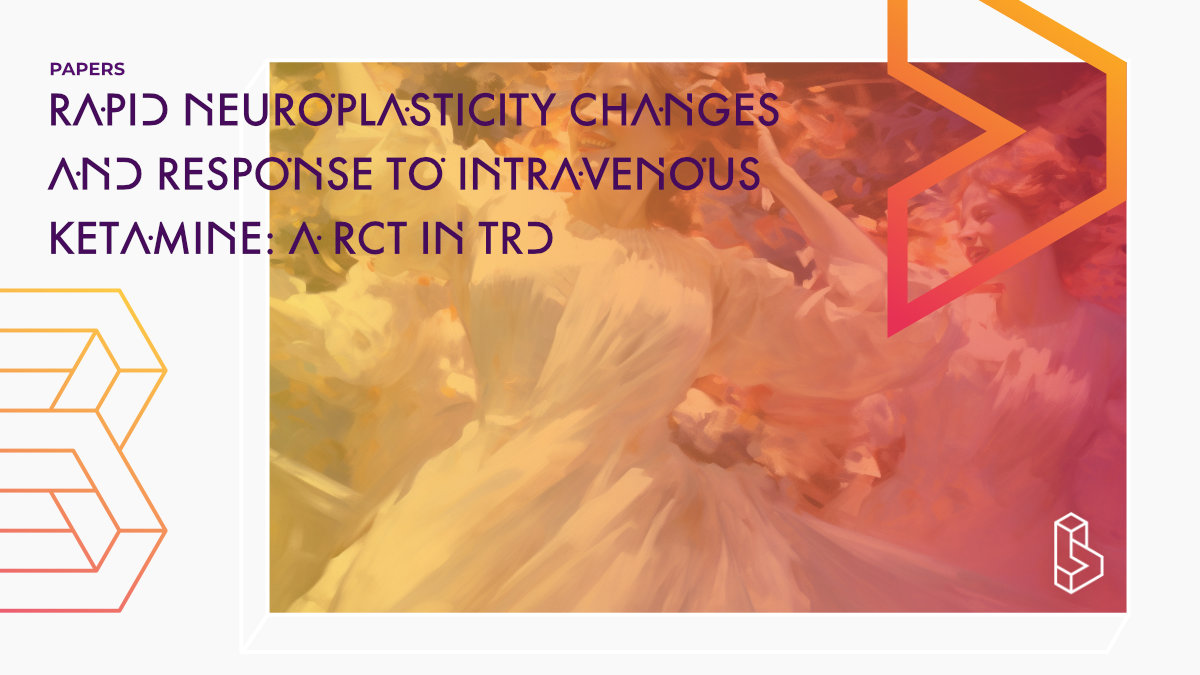This re-analysis of a randomized trial (n=98) investigates the impact of intravenous ketamine on rapidly reversing depression by enhancing neuroplasticity. The study found that greater decreases in mean diffusivity, a marker of microstructural neuroplasticity, from pre-infusion to 24-hour post-infusion were associated with larger improvements in depression scores, particularly in the left BA10 and left amygdala in the ketamine group. The acute effects of ketamine on depression may be partially mediated by acute changes in neuroplasticity, as quantifiable with diffusion tensor imaging.
Abstract of Rapid neuroplasticity changes and response to intravenous ketamine
“Intravenous ketamine is posited to rapidly reverse depression by rapidly enhancing neuroplasticity. In human patients, we quantified gray matter microstructural changes on a rapid (24-h) timescale within key regions where neuroplasticity enhancements post-ketamine have been implicated in animal models. In this study, 98 unipolar depressed adults who failed at least one antidepressant medication were randomized 2:1 to a single infusion of intravenous ketamine (0.5 mg/kg) or vehicle (saline) and completed diffusion tensor imaging (DTI) assessments at pre-infusion baseline and 24-h post-infusion. DTI mean diffusivity (DTI-MD), a putative marker of microstructural neuroplasticity in gray matter, was calculated for 7 regions of interest (left and right BA10, amygdala, and hippocampus; and ventral Anterior Cingulate Cortex) and compared to clinical response measured with the Montgomery-Asberg Depression Rating Scale (MADRS) and the Quick Inventory of Depressive Symptoms-Self-Report (QIDS-SR). Individual differences in DTI-MD change (greater decrease from baseline to 24-h post-infusion, indicative of more neuroplasticity enhancement) were associated with larger improvements in depression scores across several regions. In the left BA10 and left amygdala, these relationships were driven primarily by the ketamine group (group * DTI-MD interaction effects: p = 0.016–0.082). In the right BA10, these associations generalized to both infusion arms (p = 0.007). In the left and right hippocampus, on the MADRS only, interaction effects were observed in the opposite direction, such that DTI-MD change was inversely associated with depression change in the ketamine arm specifically (group * DTI-MD interaction effects: p = 0.032–0.06). The acute effects of ketamine on depression may be mediated, in part, by acute changes in neuroplasticity quantifiable with DTI.”
Authors: Jared Kopelman, Timothy A. Keller, Benjamin Panny, Angela Griffo, Michelle Degutis, Crystal Spotts, Nicolas Cruz, Elizabeth Bell, Kevin Do-Nguyen, Meredith L. Wallace, Sanjay J. Mathew, Robert H. Howland & Rebecca B. Price
Summary of Rapid neuroplasticity changes and response to intravenous ketamine
Deficits in neuroplasticity are seen in both depressed human subjects and rodent models of depression-like behaviour and may be a core mechanism underlying the disorder. Effective antidepressant therapies have been shown to reverse many of these deficits.
Depressed patients show reduced markers of neuroplasticity, including reduced BDNF and decreased synapses and synapse-related gene expression, as well as decreased functional integration across key corticolimbic structures.
Ketamine, a dissociative anaesthetic, has rapid and robust antidepressant effects, including in treatment-resistant patients for whom other therapies have been ineffective. Ketamine induces markers of neuroplasticity in depression-relevant brain regions, including increased BDNF release and the stimulation of mTOR signalling.
Find this paper
https://doi.org/10.1038/s41398-023-02451-0
Open Access | Google Scholar | Backup | 🕊
Cite this paper (APA)
Kopelman, J., Keller, T. A., Panny, B., Griffo, A., Degutis, M., Spotts, C., Cruz, N., Bell, E., Do-Nguyen, K., Wallace, M. L., Mathew, S. J., Howland, R. H., & Price, R. B. (2023). Rapid neuroplasticity changes and response to intravenous ketamine: A randomized controlled trial in treatment-resistant depression. Translational Psychiatry, 13, 159.
Study details
Compounds studied
Ketamine
Topics studied
Depression
Neuroscience
Study characteristics
Placebo-Controlled
Double-Blind
Randomized
Re-analysis
Participants
98
Humans
Compound Details
The psychedelics given at which dose and how many times
Ketamine 35 mg | 1xLinked Research Papers
Notable research papers that build on or are influenced by this paper
One-Year Outcomes Following Intravenous Ketamine Plus Digital Training Among Patients with Treatment-Resistant DepressionThis follow-up to a randomized clinical trial (n=154) of adults with treatment-resistant depression (TRD) examined the impact of a digital intervention, automated self-association training (ASAT), on prolonging the antidepressant effect of a single ketamine infusion. The trial found that ketamine, followed by four days of ASAT, resulted in a significant effect on depression that lasted for three months, though the benefit was not sustained in months 4 to 12.
A Novel, Brief, Fully Automated Intervention to Extend the Antidepressant Effect of a Single Ketamine Infusion: A Randomized Clinical Trial
This double-blind, placebo-controlled study (n=154) of ketamine (35mg/70kg) (or placebo) with (and without) positive self-regard training (automated self-association training) finds that the combination can extend the positive antidepressant (MADRS) effects of ketamine, whilst the effects of ketamine alone was not distinguishable from placebo 30 days later.
Linked Clinical Trial
Intravenous Ketamine Plus Neurocognitive Training for DepressionThis study has two aims: 1) to characterize the effects of intravenous ketamine on neurocognitive markers in depressed patients; 2) to test the efficacy of a synergistic intervention for depression combining intravenous ketamine with neurocognitive training.

